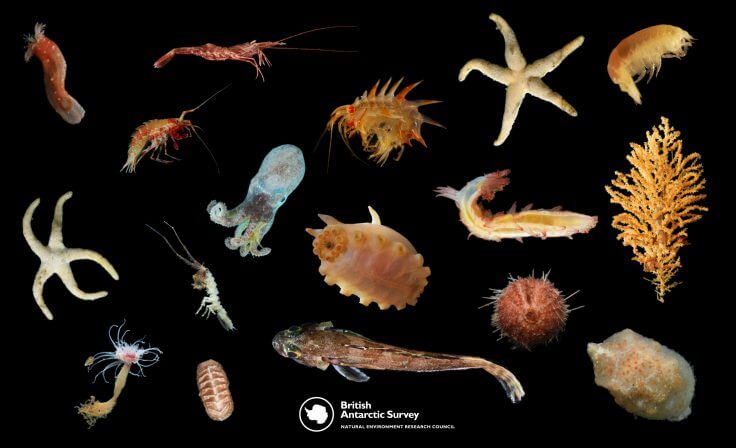
Unimaginable Diversity of Life Discovered Beneath Antarctic Ice Shelf
This is an unprecedented level of species diversity for an environment that has never seen sunlight.
By Cameron Duke | Live Science
Deep beneath Antarctica‘s ice shelves, researchers have discovered dozens of life-forms thriving on a tiny patch of the seafloor — an unprecedented level of species diversity for an environment that has never seen sunlight.
“If you had asked me three questions at the manuscript onset,” said study co-author David Barnes, a marine biologist with the British Antarctic Survey, “How much richness of life will we find? Not much. How abundant is it going to be? Not very. What’s it’s growth going to be like? Very slow. And I would have been wrong on every point.”
Far below Antarctic ice, shielded from the energizing rays of the sun, life can exist, but it was thought to be rare. As most ecosystems are built on a foundation of photosynthetic organisms like plants or algae, such dark realms shouldn’t have enough food to support a wide variety of life.
But when Gerhard Kuhn and Raphael Gromig of the Alfred Wegener Institute used boiling hot water to bore through 656 feet (200 meters) of ice on the Ekström Ice Shelf in 2018, they were surprised by what they were able to scoop from the seafloor another 328 (100 m) down.
The ice shelves cover 600,00 square miles (1.6 million square kilometres) of ocean, and what lies beneath the ice may very well be Earth‘s least explored undersea habitat.
In such a dark and seemingly inhospitable environment, the team found fragments of living organisms. When they realized that they had found more than they expected, Claus-Dieter Hillenbrand, a sedimentologist with the British Antarctic Survey, recommended sending the seafloor sample to Barnes.
The pieces that had been pulled from underneath the ice shelf, when examined with a microscope, were clearly from different animals. All told, Barnes identified 77 different species, far more than he should have reasonably found. This one sample was even richer with species than he would have expected from a survey of the open shelf.
“Is this a practical joke?” Barnes recalled thinking as he examined the specimens. “This is like a whole research cruise worth of samples, yet it came from just one drill hole.”
Many of the species identified were bryozoans, or stationary filter feeders that often look like a brain or moss, such as Melicerita obliqua and tube-feeding worms such as Paralaeospira sicula, among others. “This discovery of so much life living in these extreme conditions is a complete surprise and reminds us how Antarctic marine life is so unique and special,” Barnes told Live Science.
Finding such rich life underneath the ever-present ice sheet is one thing, but explaining why it is there is another matter entirely. Marine life, especially filter feeders like bryozoans, sponges and jellyfish, should, in theory, become scarcer with distance from the open sea; that’s because they feed on algae, which needs sunlight, and because they were thought to be too delicate for the brutal 28 degrees Fahrenheit (minus 2.2 degrees Celsius) temperatures.
But it turns out these animals are feasting on microorganisms like ciliates and dinoflagellates that are swept underneath the ice shelf by oceanic currents. “The surprise is that enough of it gets under there,” Barnes said.
When you look at the seafloor communities on the polar continental shelf underneath ice-free water, they are not limited by food.
Instead, they get way more than they could ever consume. On top of that, they don’t consume much. These are animals that stick to the floor, and they don’t build big bodies made of energy-hungry tissues. As such, they can survive off of the trickle of food that does come their way.
“It’s life in the super-slow lane,” Barnes said.
What’s more, carbon dating reveals these bottom-dwellers are not new tenants under Antarctica’s shelves.
“Despite living 3-9 km from the nearest open water, an oasis of life may have existed continuously for nearly 6000 years under the ice shelf,” Kuhn, the leader of the drilling project, said in a statement. While the oldest remnants were 5,800 years, they have only dated 20 of the hundreds of fragments. Future data may very well push this estimate farther into the past. However long it has existed, it is clear life has existed for millennia here in near-isolation.
“This may be the most undisturbed habitat on Earth,” Barnes said of the space between the seafloor and the ice above it.
That lack of disturbance, he said, may explain the ecosystem’s species diversity. Underneath the ice, there are no storms, no floods and no fires, allowing all the species that can survive the time and stability needed to radiate to every available niche.
Yet pristine habitats like these might be some of the first to succumb to human-caused climate change, Barnes said. As the Antarctic ice shelves recede, these unique environments may be lost.
And once lost, the environment can never be recreated. “People talk about recreating and re-wilding, and trying to protect and preserve,” Barnes said, “But there’s no doing that here, is there?”
This study was published Dec. 20 in the journal Current Biology.
This article was originally published by Live Science.
